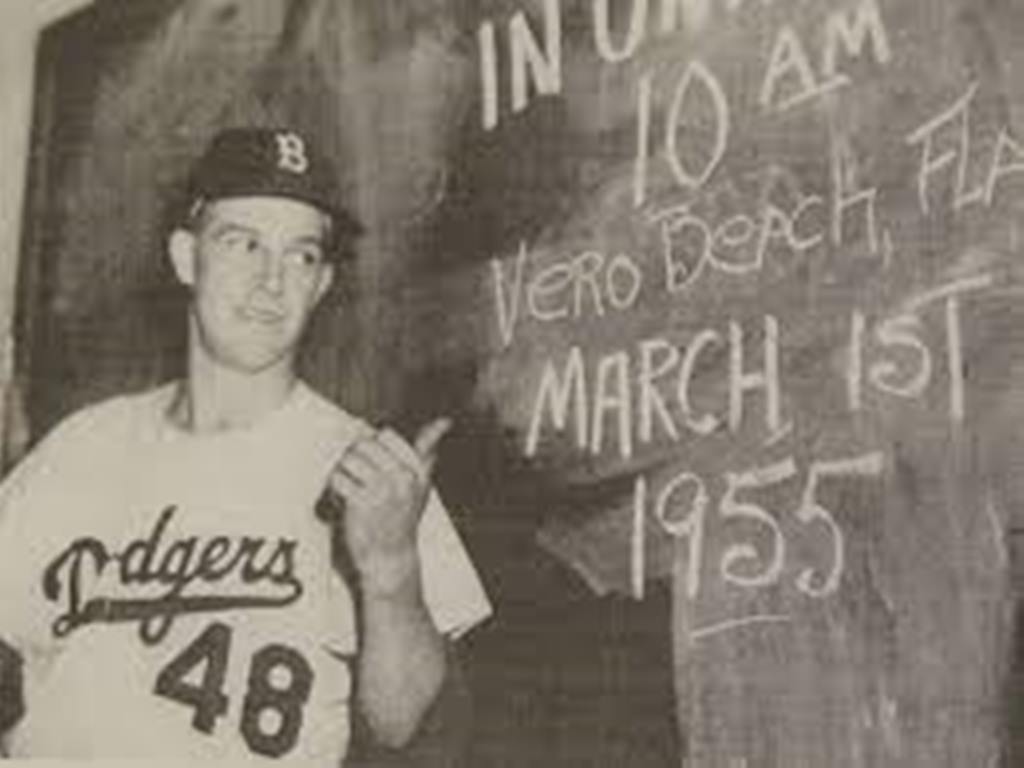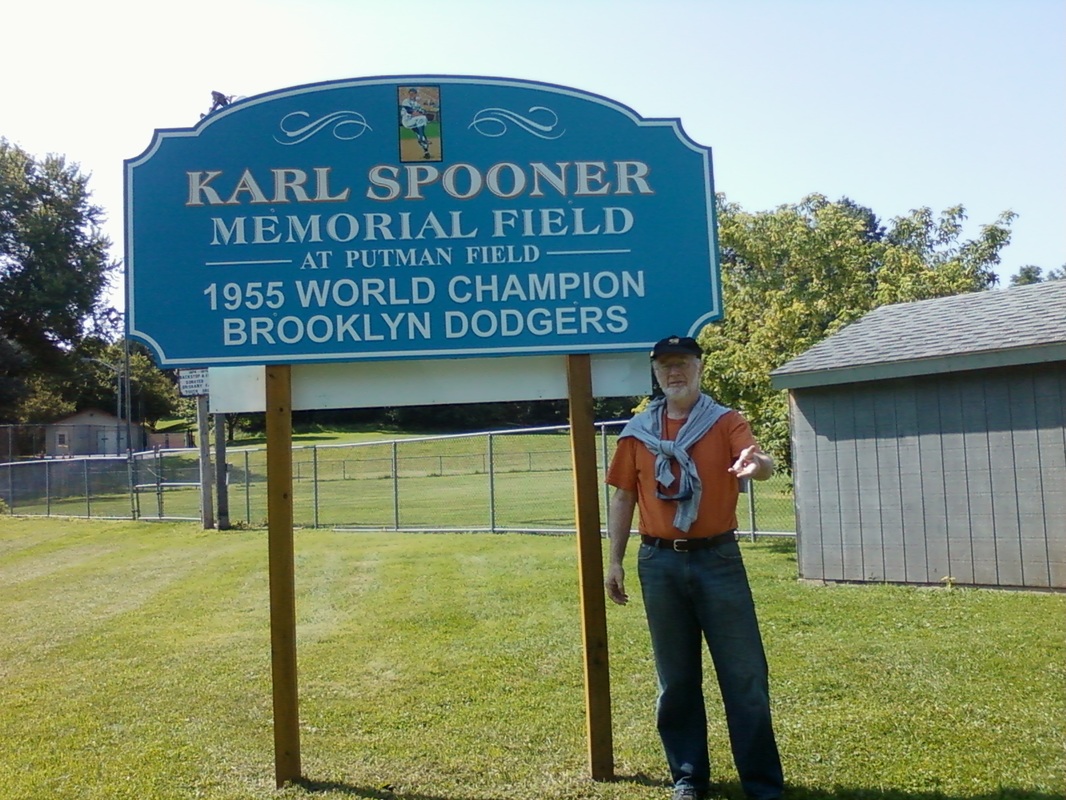|
We were driving through upstate New York and I saw a sign for Oriskany Falls.
Right away, I flashed to a ball park in Brooklyn on the last day of the 1954 season, the Dodgers and Pirates playing out the string. Before Sandy Koufax became Sandy Koufax, before Clayton Kershaw was invented, there was Karl Spooner. I was there, one of 9,344 fans. A lefty from the minors, who had shut out the hated Giants on Thursday, came back and shut out the Pirates on Sunday. Eighteen innings in his first two games. Seven hits. Twenty-seven strikeouts. No runs. One of the best two-game debuts in major-league history. As my friend and I took three subway lines back to Queens that day, we envisioned the career ahead for Karl Spooner. As Brooklyn Dodger fans always said, wait til next year. Next year arrived, and Spooner had an 8-6 record, and the Dodgers finally won a World Series. But he had already blown out his shoulder in spring training of 1955, and never again pitched in the majors. Nowadays, there might be an operation for it, but by 1958, he was retired and living in Vero Beach, Fla., the training base of the team that had just deserted us. He died in 1984 at the age of 52. I ascertained via the Internet that a ball field is named for Spooner in Oriskany Falls, so my brother and I made a detour and asked a nice man at the filling station for directions. “I saw him pitch in 1954,” I said. I asked whether people in town still remembered Karl Spooner, and he said a few. I did not ask for their names or numbers; I had my own memories. We found the field down the hill. This being America in 2014, nobody was on the ball field – no league game, no kids playing choose-up, no game of catch. There was a modest sign, painted in Dodger blue, and on the other side facing the field is a resumé of Spooner’s career, from childhood to Ebbets Field. The records were compiled by Dr. Rich Cohen. “My friend, my doctor,” said my kid brother Christopher Vecsey, a professor at Colgate University. They umpire Little League games together, and every spring they gambol in a game of town ball, the ancestor of modern baseball. Dr. Cohen has also written a lovely biography of Spooner for SABR: http://sabr.org/bioproj/person/b6f00e89 My brother said he might take his grown son, who still pitches in an adult league, to this field. He can imagine his son taking aim at the short porch in right field. I strolled out to the mound and approximated a left-handed delivery, in homage to the man I saw pitch in 1954.
Gene Palumbo
8/13/2014 07:28:39 am
A good one, George. Thanks for this.
George Vecsey
8/14/2014 01:20:06 pm
Gene, you are absolutely right. Craig was 3-0 in his first 3 starts in July of 1955, but no shutouts. You know your Brooklyn Dodgers. GV
Mendel
8/14/2014 07:49:22 am
In Israel, I am one of a few who refers to the Golan Heights as "upstate." Last I checked there were no ball fields to be found there. 8/14/2014 04:15:09 pm
Mendel 8/14/2014 10:00:20 am
Nice flashback!! It is always more interesting when you leave the main road to explore things.
charlie vincent
8/14/2014 11:31:17 am
George: Wow, you never know what memories you might touch when you put something down in black and white. My dad's younger brother. Al Vincent, spent a lifetime in baseball and was manager of the Fort Worth Cats in the Texas League in 1954 when the Dodgers called Spooner up from his club. I was 14 at the time and remember it well and all the expectations and ultimate disappointment. A great baseball story
George Vecsey
8/15/2014 06:36:03 am
Charlie, I remember the name.....never knew you were related. Lots of Dodgers came through Fort Worth....G
Ed Martin
8/14/2014 02:08:51 pm
George, I enjoyed remembering Karl Spooner, "Lefty" is locked in my memory with his name. Another strong starter who hurt his arm when seemingly headed for stardom for the Dodgers in 1947 was Harry Taylor. (from SABR). "In 1947 Taylor made the team out of spring training, winning a spot in the bullpen. But on May 28, with the Dodgers trailing the Chicago Cubs by a half game, new manager Burt Shotten inserted Taylor into the starting rotation. Harry pitched a complete-game five-hitter to defeat the New York Giants, 14–2. He also had two hits and two runs batted in. Taylor’s win and a Cubs’ loss put Brooklyn into first place. Four days later he pitched another complete game in leading the Dodgers to a 6–1 victory over St. Louis, and he followed with a two-hit shutout against Pittsburgh. By July 4 Taylor had seven victories and seven complete games in ten starts. On July 29 Taylor’s three-hit shutout at St. Louis helped the Dodgers stretch their lead to eight games over the New York Giants.
George Vecsey
8/14/2014 03:26:04 pm
The Mets had a lefty named Grover Powell who shut out the Phillies in 1963. I was there, a young reporter. We were standing around Powell in the crowded dressing room, asking him our Chipmunk-style questions, and Casey Stengel stood at the edge of the media scrum and blurted: "Wuz you born in Poland?" That was Powell's only major-league victory in 20 games.
Charlie Accetta
8/14/2014 03:58:33 pm
GV - A moment in the sun is better than none, but the memory of the light is small comfort on a cold night.
George Vecsey
8/15/2014 06:39:23 am
Charlie, absolutely. Nothing is promised. Careers can end so quickly, before they are begun. I saw Steve Dalkowski pitch in March of 1983...but he never made the majors. Baseball is great about isolating one game, one performance. Thanks for the perspective. GV 8/14/2014 04:19:26 pm
I am always in awe of the collective recall of this group, particularly the Dodger fans. You all either have fantastic recall or a team of fact checkers.
Mike from Whitestone
8/15/2014 08:13:53 am
GV, Comments are closed.
|
Categories
All
|











